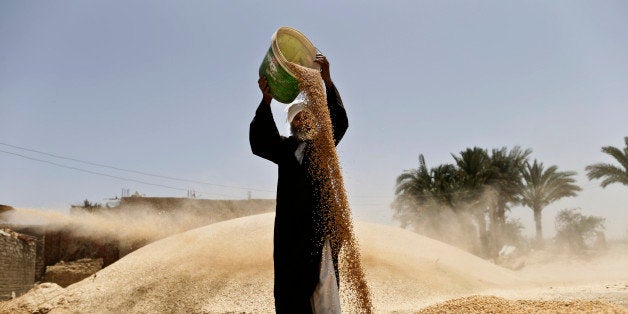
Feeding our growing population with a sustainable, healthful diet is a global challenge. In the Middle East and North Africa (MENA) region this challenge is particularly complex. However, this region has an enormous amount of innovation, technology, resources and expertise. Let's use them to build a food system that has at its core the provision of sustainable, nutritious diets that are accessible to all.
Co-authored by Dr. Gunhild A. Stordalen and Mohamed Saleh Bashanfr
With almost every country in the world dealing with some form of malnutrition, and with food production being the single most important driver of climate change and environmental damage, feeding our growing population with a sustainable, healthful diet is a global challenge. In the Middle East and North Africa (MENA) region this challenge is particularly complex.
In contrast to all other regions of the world, the number of undernourished people has increased from 16 million between 1990 an 1992 to 33 million today. Almost one third of children under the age of 5 face lifelong health and development impairment due to insufficient access to nutritious foods. At the same time, the region is grappling with rising rates of obesity, creating an unforeseen "double burden" of malnutrition. Indeed, over 50 percent of the region's adult population is currently overweight or obese, causing a dramatic increase in non-communicable diseases (NCDs) such as diabetes and heart disease, placing an enormous burden on the healthcare systems. This has become the new "normal" face of malnutrition.
The bad news is that the MENA food system is getting more complex. Climate change, population growth, shifts towards urban living and the adoption of Western diets bring mutually reinforcing challenges. The MENA region has the highest rate of population growth worldwide and a rapidly growing urban population, with 66 percent of people expected to be living in cities by 2030. These trends place enormous pressures on the environment and finite resources such as fresh water and land. Half of the population in the MENA region already lives under conditions of water stress. With the population expected to grow to nearly 700 million in 2050, per capita water availability will be halved.
The impacts go far beyond poor health. Recent research by the International Food Policy Research Institute (IFPRI) revealed that food insecurity is one of the main drivers of unrest and conflict in the MENA region. Economic performance is also compromised by poor nutrition. In Egypt alone it is estimated that the consequences of child malnutrition reduces GDP by almost 2 percent.
Tackling the emerging public health crisis without exacerbating climate change and environmental damage requires a radical rethinking of the entire region's food system, from producer and importer to the end consumer. This will not be an easy task, but there are some priorities that can change the current paradigm.
First, improving nutrition and minimizing the environmental footprint of the food system by making food supplies more diverse, nutritious and sustainable is essential. This means rebalancing production from mono crops and cereals, dairy and meat towards the more diverse production of fruit, vegetables and semi-arid nutritious crops that use less water and are more heat-tolerant. Smallholder farmers, who are often among the most malnourished and frequently lack the technology and knowledge necessary to be more efficient and sustainable, are crucial stakeholders in diversifying the food system.
Second, urgent action must be taken to tackle the growing burden of obesity and NCDs in the region. Changing the increasingly obesogenic environment must become a top priority, ensuring access to healthful and affordable food for all. A new policy framework aimed at protecting consumers, especially children, from unhealthful diets that are high in added salt, sugar and saturated fats and low in micronutrients is vital. Measures and incentives to ensure that healthful, diverse and sustainably produced foods become easily available and economically affordable must be developed.
Third, investment is needed to facilitate the development of interventions that can improve nutrition in a cost-effective, sustainable way. Fortifying staple foods and condiments with nutrients, for example, is both effective and cheap, costing as little as a few cents per person per year. There has been significant progress in the region since Saudi Arabia first made adding iron, folic acid and vitamin A to wheat flour mandatory in 1978. Afghanistan, Bahrain, Jordan, Kuwait, Qatar, the United Arab Emirates, Iran, Iraq, Morocco, Oman and Yemen are now all using fortification to reduce micronutrient deficiencies among vulnerable groups. But there is still much to be done to expand these programs in the region.
Finally, the private sector needs to be engaged in a meaningful way in finding solutions to a more sustainable and nutritious food system. The food industry is a key stakeholder and a major catalyst for change, so it is important that businesses be included in a multi-stakeholder dialogue. This will enable policymakers to create regulatory frameworks that encourage the private sector to step up to the nutrition challenge and create more sustainable business models.
Today, the international community is coming to terms with the importance of addressing the multiple, overlapping challenges of the food system. But it's not enough to merely imagine what a better food system will look like. The MENA region has an enormous amount of innovation, technology, resources and expertise. Let's use them to build a food system that has at its core the provision of sustainable, nutritious diets that are accessible to all.
Dr. Gunhild A. Stordalen, M.D., Ph.D., is the founder and director of EAT, and Mr. Mohamed Saleh Bashanfr is a managing partner at SECOSALT and the head of the Food Specialties Committee of the Egyptian Food Chamber within Egypt's Ministry of Trade and Industry.
This blog post is based on speeches given at the EATx MENA event, coinciding with the Global Forum for Innovation in Agriculture 2015 in Abu Dhabi, and appeared on the World Economic Forum blog to mark WEF Middle East and North Africa.